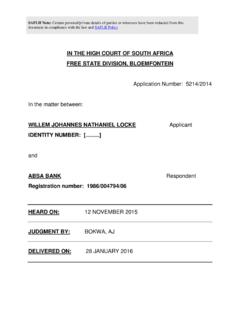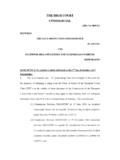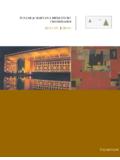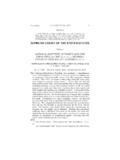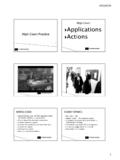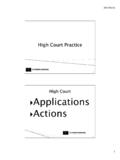Transcription of High Court of Australia - Lindy Chamberlain
1 high Court of Australia Chamberlain v. THE QUEEN ( ) (1984) 153 CLR 521 Criminal Law - Evidence - Federal Court Court high Court of Australia Gibbs (1), Mason(1), Murphy(2), Brennan(3) and Deane(4) JJ. HRNG 1983, November 28-30; 1984, February 22. #DATE 22:2:1984 JUDGE1 1984, February 22. The following written judgments were delivered:- GIBBS AND MASON J. The applicants, Alice Lynne Chamberlain and Michael Leigh Chamberlain , are wife and husband. By an indictment presented to the Supreme Court of the Northern Territory, Mrs. Chamberlain was charged that on 17 August 1980 at Ayers Rock in the Northern Territory she did murder Azaria Chantel Loren Chamberlain . By the second count of the indictment, Mr. Chamberlain was charged as an accessory after the fact, the particulars being that between 17 August 1980 and 16 December 1981 at Ayers Rock, Alice Springs and other places in the Northern Territory he did receive or assist another person, namely Alice Lynne Chamberlain , who to his knowledge was guilty of an offence against the law of the Territory, namely the offence of murdering Azaria Chantel Loren Chamberlain at Ayers Rock on 17 August 1980, in order to enable the said Alice Lynne Chamberlain to escape punishment.
2 Each pleaded not guilty but the jury found both to be guilty as charged. They appealed against their convictions to the Full Court of the Federal Court . That Court (Bowen , Forster and Jenkinson JJ.) dismissed the appeals. They now apply for special leave to appeal against that decision. (at p523) 2. A question that arises at the outset of the case is whether the Full Court of the Federal Court had power to allow the appeal on the ground that the verdicts were unsafe, unsatisfactory or dangerous. A majority of the Full Court in the present case (Bowen and Forster J.), following an earlier decision of the Federal Court in Duff v. The Queen (1979) 39 FLR 315; 28 ALR 663 , held that such a ground of appeal could not be entertained. The third member of the Court , Jenkinson J., said that he was "free of any such doubt as to the guilt of the appellants as might justify a conclusion that the verdicts were unsafe or unsatisfactory" and that he did not himself entertain any reasonable doubt of the guilt of either appellant.
3 He therefore considered it unnecessary to express, and refrained from expressing, any concluded opinion as to whether the decision in Duff v. The Queen on this point was correct. (at p524) 3. Immediately before the Federal Court of Australia Act 1976 (Cth) came into operation, appeals by persons convicted on indictment before the Supreme Court of the Northern Territory lay to the high Court . Section 47(1) of the Northern Territory Supreme Court Act 1961 (Cth), as amended, provided as follows: "A person convicted on indictment before the Supreme Court may appeal to the high Court - (a) against his conviction on any ground of appeal that involves a question of law alone; (b) with the leave of the Supreme Court or a Judge, on any ground of appeal that involves a question of fact alone or a question of mixed law and fact; (c) with the leave of the high Court , on any ground of appeal mentioned in the last preceding paragraph, or on any other ground that appears to the high Court to be a sufficient ground of appeal.
4 And (d) with the leave of the high Court , against the sentence passed on his conviction, unless the sentence is one fixed by law, and the high Court has jurisdiction to hear and determine the appeal." That section was repealed by the Northern Territory Supreme Court Amendment Act 1976 (Cth) which took effect on the day on which the Federal Court of Australia Act came into operation. By s. 24(1) to (4) of the Federal Court of Australia Act it is provided as follows: "(1) Subject to this section and to any other Act, whether passed before or after the commencement of this Act (including an Act by virtue of which any judgments referred to in this section are made final and conclusive or not subject to appeal), the Court has jurisdiction to hear and determine - (a) appeals from judgments of the Court constituted by a single Judge; (b) appeals from judgments of the Supreme Court of a Territory; and (c) in such cases as are provided by any other Act, appeals from judgments of a Court of a State, other than a Full Court of the Supreme Court of a State, exercising federal jurisdiction.
5 (2) On or after the commencing day an appeal shall not be brought to the high Court from a judgment of the Supreme Court of a Territory except - (a) in accordance with special leave given by the high Court on or after the commencing day; or (b) in accordance with leave or special leave given by the high Court or the Supreme Court before the commencing day. (3) Subject to sub-section (4), an appeal does not lie to the Court from a judgment of the Supreme Court of a Territory given before the commencing day. (4) Where, immediately before the commencing day, a person has a right to appeal (otherwise than in accordance with leave or special leave referred to in sub-section (2)), or to seek leave or special leave to appeal, to the high Court from a judgment of the Supreme Court of a Territory given before the commencing day, that right is, by force of this section, converted into a corresponding right to appeal, or to seek leave or special leave to appeal, to the Court .
6 " Section 25(1) provides that the appellate jurisdiction of the Court shall, subject to immaterial exceptions, be exercised by a Full Court . The powers of the Court on appeal are described in ss. 27 and 28 of the Federal Court of Australia Act. Section 27 provides as follows: "In an appeal, the Court shall have regard to the evidence given in the proceedings out of which the appeal arose, and has power to draw inferences of fact and, in its discretion, to receive further evidence, which evidence may be taken on affidavit, by oral examination before the Court or a Judge or otherwise in accordance with section 46." Section 28(1) provides as follows: "Subject to any other Act, the Court may, in the exercise of its appellate jurisdiction - (a) affirm, reverse or vary the judgment appealed from; (b) give such judgment, or make such order, as, in all the circumstances, it thinks fit, or refuse to make an order; (c) set aside the judgment appealed from, in whole or in part, and remit the proceeding to the Court from which the appeal was brought for further hearing and determination, subject to such directions as the Court thinks fit; (d) set aside a verdict or finding of a jury in a civil proceeding, and enter judgment notwithstanding any such verdict or finding.
7 (e) set aside the verdict and judgment in a trial on indictment and order a verdict of not guilty or other appropriate verdict to be entered; (f) grant a new trial in any case in which there has been a trial, either with or without a jury, on any ground upon which it is appropriate to grant a new trial; or (g) award execution from the Court or, in the case of an appeal from another Court , award execution from the Court or remit the cause to that other Court , or to a Court from which a previous appeal was brought, for the execution of the judgment of the Court ." Section 28(5) provides as follows: "The powers of the Court under sub-section (1) in an appeal (whether by the Crown or by the defendant) against a sentence in a criminal matter include the power to increase or decrease the sentence or substitute a different sentence.
8 " (at p526) 4. Duff v. The Queen (1979) 39 FLR 315; 28 ALR 663 was a decision on the power of the Federal Court on an appeal from the Supreme Court of the Australian Capital Territory. There is however no possible ground of distinction between appeals from that Court and appeals from the Supreme Court of the Northern Territory. Before the enactment of the Federal Court of Australia Act, appeals from the Supreme Court of the Australian Capital Territory lay to the high Court , under s. 52 of the Australian Capital Territory Supreme Court Act 1933 (Cth), as amended, a section which was indistinguishable in effect from s. 47 of the Northern Territory Supreme Court Act. Section 52, like s. 47, was repealed on the day on which the Federal Court of Australia Act came into operation: see Australian Capital Territory Supreme Court Amendment Act 1976 (Cth).
9 In Collins v. The Queen (1980) 31 ALR 257, at p 261 , it was correctly assumed that the decision in Duff v. The Queen was equally applicable to appeals from the Northern Territory. (at p526) 5. The reasons given by the learned judges who constituted the Full Court in Duff v. The Queen for reaching their conclusion that the powers of the Federal Court in criminal appeals were limited in the way that we have mentioned appear at pp. 670-675 of the report and may be summarized as follows. The powers of a Court of Criminal Appeal to set aside a jury verdict depend on the statute creating the appellate jurisdiction. No grounds upon which the criminal appellate jurisdiction of the Federal Court may be exercised are specified in the Federal Court of Australia Act. It is clear that the appellate powers of the Federal Court are not limited to the hearing and determination of an appeal in the strict sense, and the grounds upon which it may allow an appeal therefore cannot be restricted to those which govern the determination of a strict appeal.
10 The grounds upon which, at common law, new trials may be granted after judgments entered on jury verdicts govern the determination of an application for a new trial under s. 28(1)(f), and the words "on any ground upon which it is appropriate to grant a new trial" which appear in that paragraph (and which do duty both for criminal and civil appeals) refer to the grounds on which the verdict may be set aside as well as to the considerations to be taken into account in deciding whether a new trial should be ordered or whether the conviction should simply be quashed. Since it would be anomalous if the grounds for setting aside a verdict and judgment varied according to the relief which was sought or allowed, "the criteria for setting aside a jury verdict which are furnished by the new trial grounds are equally appropriate to govern the exercise of the power to set aside a jury verdict and to substitute another verdict under s.

